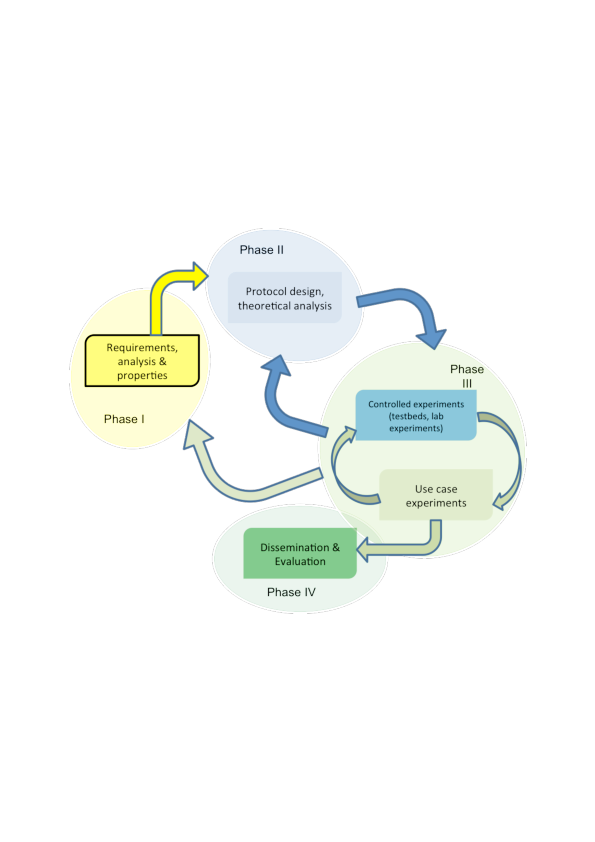Section: Research Program
Introduction
We will focus on wireless ubiquitous networks that rely on constrained devices, i.e. with limited resources in terms of storage and computing capacities. They can be sensors, small robots, RFID readers or tags. A wireless sensor retrieves a physical measure such as light. A wireless robot is a wireless sensor that in addition has the ability to move by itself in a controlled way. A drone is a robot with the ability to manoeuvre in 3D (in the air or in the water). RFID tags are passive items that embed a unique identifier for a place or an object allowing accurate traceability. They can communicate only in the vicinity of an RFID reader. An RFID reader can be seen as a special kind of sensor in the network which data is the one read on tags. These devices may run on batteries that are not envisaged to be changed or recharged. These networks may be composed of ten to thousands of such heterogeneous devices for which energy is a key issue.
Today, most of these networks are homogeneous, i.e. composed of only one kind of devices. They have mainly been studied in application and technology silos. Because of this, they are approaching fundamental limitations especially in terms of topology deployment, management and communications, while exploiting the complementarity of heterogeneous devices and communication technologies would enlarge their capacities and the set of applications. Finally, these networks must work efficiently even in dynamic and realistic situations, i.e. they must consider by design the different dynamic parameters and automatically self-adapt to their variations.
Our overall goal is represented by Figure 1. We will investigate wireless ubiquitous IoT services for constrained devices by smartly combining different frequency bands and different medium access and routing techniquesover heterogeneous devices in a distributed and opportunistic fashion. Our approach will always deal with hardware constraints and take care of security and energy issues to provide protocols that ride on synergy and self-organization between devices.
The goal of the FUN project team is to provide these next generation networks with a set of innovative and distributed self-organizing cooperative protocols to raise them to a new level of scalability, autonomy, adaptability, manageability and performance. We aim to break these silos to exploit the full synergy between devices, making them cooperate in a single holistic network. We will consider them as networks of heterogeneous devices rather than a collection of heterogeneous networks.
To realize the full potential of these ubiquitous networks, there is a need to provide them with a set of tools that allow them to (i) (self-)deploy, (ii) self-organize, (iii) discover and locate each other, resources and services and (iv) communicate. These tools will be the basics for enabling cooperation, co-existence and witnessing a global efficient behavior. The deployment of these mechanisms is challenging since it should be achieved in spite of several limitations. The main difficulties are to provide such protocols in a secured and energy-efficient fashion in spite of:
-
dynamic topology changes due to various factors such as the unreliability of the wireless medium, the wireless interferences between devices, node mobility and energy saving mechanisms;
-
hardware constraints in terms of CPU and memory capacities that limit the operations and data each node can perform/collect;
-
lacks of interoperability between applicative, hardware and technological silos that may prevent from data exchange between different devices.
Objectives and methodology
To reach our overall goal, we will pursue the two following objectives, similar to the ones we set for the previous evaluation period. These two objectives are orthogonal and can be carried on jointly:
-
Providing realistic complete self-organizing tools e.g. vertical perspective.
-
Going to heterogeneous energy-efficient performing wireless networks e.g. horizontal perspective.
We give more details on these two objectives below. To achieve our main objectives, we will mainly apply the methodology depicted in Figure 2 combining both theoretical analysis and experimental validation. Mathematical tools will allow us to properly dimension a problem, formally define its limitations and needs to provide suitable protocols in response. Then, they will allow us to qualify the outcome solutions before we validate and stress them in real scenarios with regards to applications requirements. For this, we will realize proofs-of-concept with real scenarios and real devices. Differences between results and expectations will be analyzed in return in order to well understand them and integrate them by design for a better protocol self-adaptation capability.




